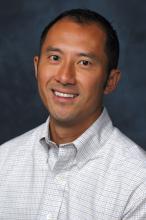SAN DIEGO – Don’t let all your patients with sickle cell anemia (SCA) and sickle cell trait (SCT) off the hook when it comes to exercise. That was the advice from Robert I. Liem, MD, a pediatric hematologist-oncologist who studies fitness.
While some patients may face risk, these conditions should pose less of a barrier to moderate- and even high-intensity exercise, Dr. Liem, of Ann & Robert H. Lurie Children’s Hospital of Chicago and Northwestern University, Chicago, said at the annual meeting of the American Society of Hematology.
“Instead of just focusing on potential harms, we should consider a paradigm shift, especially in sickle cell anemia,” he said. “There, we can start to consider the benefits of exercise, which may include some disease-modifying effects.”
There have been no formal studies into whether high-intensity exercise poses harm in patients with SCA, Dr. Liem noted. Why? There are several reasons, he said, including concern that exercise could increase sickling of red blood cells and assumptions about “sedentary behavior” in SCA.
However, there are indications that factors other than SCA may be reducing fitness in this population, a fact that could potentially be reversed by exercise.
Dr. Liem led a study that found “children and young adults with SCA have reduced exercise capacity attributable to factors independent of anemia.” The study showed that peak VO2 was 30% lower in children and young adults with SCA, compared with controls (Physiol Rep. 2015. doi: 10.14814/phy2.12338).
There are many possible explanations for this, he said, including patient-related factors such as pain during exercise and poor access to fitness resources.
Another study found low fitness in 83% of adults with SCA and identified chronic anemia as the most important factor (Am J Hematol. 2014 Aug;89[8]:819-24).
In patients with sickle cell trait, which Dr. Liem said affects an estimated 6%-9% of African-Americans, early reports of sudden death appeared in the 1960s and 1970s, and recent studies have provided more insight into the risk.
In 2012, a study tracked NCAA student athletes and found that Division I football players with SCT faced a 37-fold higher risk of exertion-related death than did athletes without SCT. Five players with SCT, all black and all Division I football players, had died over a 5-year period (Br J Sports Med 2012 Apr;46[5]:325-30).
A 2016 study, meanwhile, tracked more than 47,000 black soldiers in the U.S. Army and found those with SCT didn’t face a higher risk of death although they did have a “significantly higher risk” of exertional rhabdomyolysis (N Engl J Med. 2016 Aug 4; 375[5]:435-42).
While the cause of exercise-related harm in SCT isn’t fully understood, Dr. Liem said, it’s possible that extreme states such as severe dehydration, acidosis, and hypoxemia may trigger sickling. A combination of SCT, extreme exercise, heat, and genetic predisposition could produce harm by creating a “perfect storm,” he added.
Should patients with SCA or SCT exercise? Yes, Dr. Liem said, pointing to the importance of fitness in the general population.
Exercising to volitional exhaustion appears to be safe in children and adults with SCA, he said, and lack of exercise could lead to a variety of negative effects on growth in children and on quality of life.
There are “limited but promising data” linking exercise to benefits in SCA and SCT populations, he said.
Moving forward, Dr. Liem noted that guidelines from the NCAA and National Athletic Trainers’ Association offer insight into exercise best practices in SCT. They’re designed to promote acclimation during training, access to fluids, and prompt recognition of symptoms of heat-related illness and a condition known as “exercise collapse associated with sickle trait.”
However, there are no guidelines for exercise in SCA and it’s not helpful to let patients set limits on themselves based on the symptoms they experience, he said.
Dr. Liem reported having no relevant financial disclosures.


